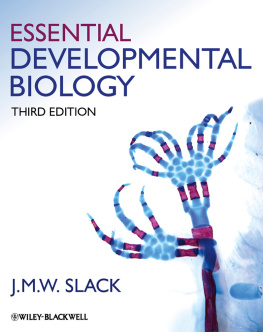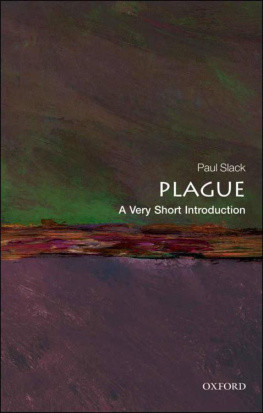Slack - Essential Developmental Biology
Here you can read online Slack - Essential Developmental Biology full text of the book (entire story) in english for free. Download pdf and epub, get meaning, cover and reviews about this ebook. year: 2012, publisher: John Wiley & Sons, Inc., genre: Romance novel. Description of the work, (preface) as well as reviews are available. Best literature library LitArk.com created for fans of good reading and offers a wide selection of genres:
Romance novel
Science fiction
Adventure
Detective
Science
History
Home and family
Prose
Art
Politics
Computer
Non-fiction
Religion
Business
Children
Humor
Choose a favorite category and find really read worthwhile books. Enjoy immersion in the world of imagination, feel the emotions of the characters or learn something new for yourself, make an fascinating discovery.
- Book:Essential Developmental Biology
- Author:
- Publisher:John Wiley & Sons, Inc.
- Genre:
- Year:2012
- Rating:4 / 5
- Favourites:Add to favourites
- Your mark:
- 80
- 1
- 2
- 3
- 4
- 5
Essential Developmental Biology: summary, description and annotation
We offer to read an annotation, description, summary or preface (depends on what the author of the book "Essential Developmental Biology" wrote himself). If you haven't found the necessary information about the book — write in the comments, we will try to find it.
Slack: author's other books
Who wrote Essential Developmental Biology? Find out the surname, the name of the author of the book and a list of all author's works by series.
Essential Developmental Biology — read online for free the complete book (whole text) full work
Below is the text of the book, divided by pages. System saving the place of the last page read, allows you to conveniently read the book "Essential Developmental Biology" online for free, without having to search again every time where you left off. Put a bookmark, and you can go to the page where you finished reading at any time.
Font size:
Interval:
Bookmark:


This edition first published 2013; 2001, 2006 Blackwell Publishing Ltd, 2013 by John Wiley & Sons, Ltd
Wiley-Blackwell is an imprint of John Wiley & Sons, formed by the merger of Wileys global Scientific, Technical and Medical business with Blackwell Publishing.
Registered office: John Wiley & Sons, Ltd, The Atrium, Southern Gate, Chichester, West Sussex, PO19 8SQ, UK
Editorial offices: 9600 Garsington Road, Oxford, OX4 2DQ, UK
The Atrium, Southern Gate, Chichester, West Sussex, PO19 8SQ, UK
111 River Street, Hoboken, NJ 07030-5774, USA
For details of our global editorial offices, for customer services and for information about how to apply for permission to reuse the copyright material in this book please see our website at www.wiley.com/wiley-blackwell.
The right of the author to be identified as the author of this work has been asserted in accordance with the UK Copyright, Designs and Patents Act 1988.
All rights reserved. No part of this publication may be reproduced, stored in a retrieval system, or transmitted, in any form or by any means, electronic, mechanical, photocopying, recording or otherwise, except as permitted by the UK Copyright, Designs and Patents Act 1988, without the prior permission of the publisher.
Designations used by companies to distinguish their products are often claimed as trademarks. All brand names and product names used in this book are trade names, service marks, trademarks or registered trademarks of their respective owners. The publisher is not associated with any product or vendor mentioned in this book. This publication is designed to provide accurate and authoritative information in regard to the subject matter covered. It is sold on the understanding that the publisher is not engaged in rendering professional services. If professional advice or other expert assistance is required, the services of a competent professional should be sought.
Library of Congress Cataloging-in-Publication Data
Slack, J. M. W. (Jonathan Michael Wyndham), 1949
Essential developmental biology / Jonathan M.W. Slack. 3rd ed.
p. cm.
Includes bibliographical references and index.
ISBN 978-1-118-02286-3 (hardback : alk. paper)
ISBN 978-0-470-92351-1 (paperback : alk. paper)
1. Developmental biologyLaboratory manuals. I. Title.
QH491.S6 2012
571.8'6dc23
2012008542
A catalogue record for this book is available from the British Library.
Wiley also publishes its books in a variety of electronic formats. Some content that appears in print may not be available in electronic books.
Cover design by Design Deluxe
Cover image: The cover shows a double posterior limb of an axolotl (a type of salamander), together with a normal limb. The double posterior limb arose after grafting a strip of limb rudiment tissue into the flank of a host embryo. This means that a polarizing region develops on both sides, leading to the double posterior symmetry (see Chapter 15). The specimen was made by the author using the technique first described in Slack, JMW. Determination of polarity in the amphibian limb, Nature 1976: 261:4446. It was stained and photographed by Drs Ying Chen and Gufa Lin. Red indicates bone and blue indicates cartilage.
Preface
This book presents the basic concepts and facts relating to the developmental biology of animals. It is designed as a core text for undergraduate courses from the second to the fourth year, and also for first year graduate students. The first and second editions were road tested by myself and by many other instructors, and were found suitable for both biologically based and medically oriented courses. A basic knowledge of cell and molecular biology is assumed, but no prior knowledge of development, animal structure, or histology should be necessary.
The book is arranged in four sections and the order of topics is intended to represent a logical progression. The first section introduces the basic concepts and techniques. The second covers the six main model organisms, Xenopus , zebrafish, chick, mouse, Drosophila, and Caenorhabditis elegans , describing their early development to the stage of the general body plan. The third deals with organ development, mostly of vertebrates but including also Drosophila imaginal discs. The fourth deals with some topics of high contemporary interest: growth and stem cells, regeneration, regenerative medicine, and evolution. To assist readers unfamiliar with the families of genes and molecules that are important in development, they are listed in the Appendix in the context of a short revision guide to basic molecular and cell biology.
Like the previous editions, the new version of Essential Developmental Biology differs from its main competitors in four important respects, all of which I feel are essential for effective education.
- It keeps the model organisms separate when early development is discussed. This avoids the muddle that arises all too often when students think that knockouts can be made in Xenopus , or that bindin is essential for mammalian fertilization.
- It avoids considerations of history and experimental priority because students do not care who did something first if it all happened 20 years ago.
- It does, however, explain why we believe what we do. Understanding does not come from simply memorizing long lists of gene names, so I continue to explain how to investigate developmental phenomena and what sorts of evidence are needed to prove a particular type of result.
- The work is highly focused. In order to keep the text short and concise I have not wandered off into areas such as the development of plants or lower eukaryotes, that may be very interesting but are really separate branches of biology.
The first two editions were very well received by both users and reviewers and I hope that the third edition will make this book an even more popular choice for undergraduate and graduate level teaching around the world.
The principal challenge today is that of exponentially increasing detail. The molecular life sciences seem to double in workforce and output every 10 years or so, and developmental biology has grown at least this fast since its re-founding as a molecular subject in the 1980s. But students brains do not double in size every 10 years, nor do their courses lengthen. So very serious thought has to be given to what to include and what to leave out.
I have taken the view that the value of model organisms is that they enable experiments to be performed whose results illuminate some general principle of development. However, a lot of recent research has diverged from this strategy and has focused on an ever more detailed molecular analysis of every possible process and organ system in every model organisms. Although the principles of development are common to all animals, it is inevitable that the harder you look, the more differences between organisms you will find. My view is that for a textbook at this level it is not appropriate to cover all the detailed differences between, say, myogenesis in mouse, chicken, Xenopus, and zebrafish, so I have focused on just the main themes. In the general field of organogenesis it is also not feasible to cover all of the organs in the vertebrate body. Accordingly, I have selected for inclusion those that are classic developmental biology topics, such as limb development, and those of the greatest medical importance, such as the nervous system, the heart, or the pancreas. Likewise, when considering regeneration, it is not possible to cover every structure in the living world that regenerates to some extent, so I have focused on three classic systems: the planarian, insect limbs, and vertebrate limbs.
Next pageFont size:
Interval:
Bookmark:
Similar books «Essential Developmental Biology»
Look at similar books to Essential Developmental Biology. We have selected literature similar in name and meaning in the hope of providing readers with more options to find new, interesting, not yet read works.
Discussion, reviews of the book Essential Developmental Biology and just readers' own opinions. Leave your comments, write what you think about the work, its meaning or the main characters. Specify what exactly you liked and what you didn't like, and why you think so.












